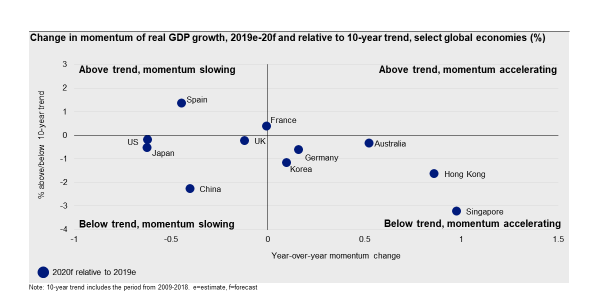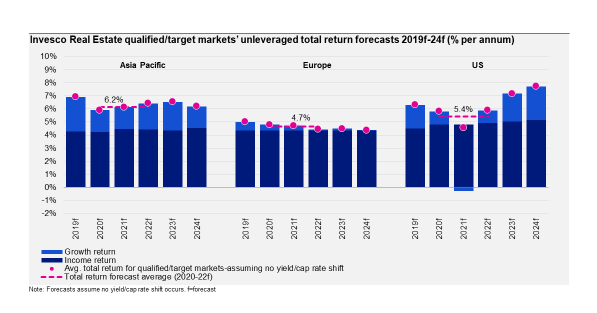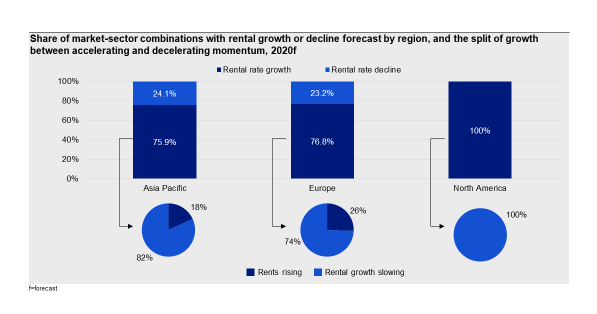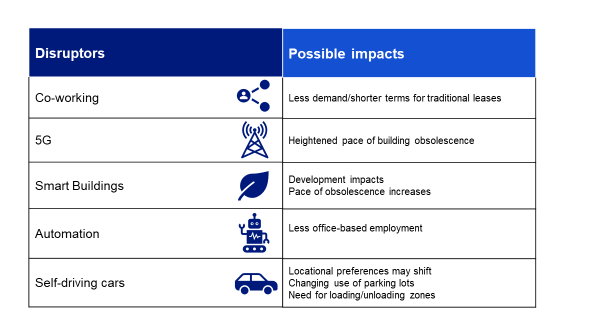2020 Outlook: Generally positive for global real estate, but balancing growth with risk is key
2020 Outlook: Generally positive for global real estate, but balancing growth with risk is key
- The outlook for global real estate in 2020 is positive, but the macro risks are elevated.
- Economic growth has moderated in 2019 but remains adequate to support real estate demand.
- “Structural offense” to take advantage of long-term drivers of real estate demand should be balanced with “cyclical defense” should one or more macro risk materialize
- Above trend growth: In 2020, Oxford Economics forecasts growth above long-term trend rates only in France and Spain; elsewhere, growth is expected to be below the long-term trend.
- Accelerating growth: GDP growth is expected to re-accelerate in 2020 in Singapore, Hong Kong, Korea, Australia and Germany, but only to rates that are below their long-term trends.
- Slowing growth: In the US, the UK and most other European countries, growth is expected to decelerate in 2020. But for most, this just means a slowdown to a level that’s close to their long-term average growth rate.
- Rental growth slowing in the US: While rents are expected to increase in all of Invesco Real Estate’s qualified market sectors in the US in 2020, they are all projected to grow more slowly than in 2019.
- Rental growth accelerating in select markets in Asia Pacific and Europe: Rents are expected to increase in roughly three-quarters of market sectors in 2020 in both Asia Pacific and Europe. Furthermore, in 18% of these in Asia Pacific and 26% in Europe, the pace of rent growth is expected to accelerate in 2020 (Figure 3).
- A narrow focus on tech and life science growth locations: Tech and life science industries are likely to be the principal drivers of new highly paid jobs over the next decade, and this seems likely to generate sub-market clusters of enduring and growing real estate demand.
- Niche segments may provide less cyclical, dispersed opportunities: The demand for sub-sectors and niches such as urban infill logistics, self-storage, health care, or hotels appear more broadly dispersed, and some may be likely to be less vulnerable to cyclical slowdown.
Invesco Real Estate shares its outlook for 2020.

Nov 19, 2019 | Tim Bellman and Joe Rodriguez
Key takeways
Economic growth has begun to moderate worldwide, as expected, but remains adequate to support real estate demand. Heading into 2020, real estate appears more attractively priced relative to other asset classes than it did in early 2019 amidst even lower long-term government bond rates, which in turn may drive additional capital into the sector as investors widen their search for yield-bearing assets.
While some risks have begun to recede (namely, upward pressures on inflation and interest rates), other geopolitical risks have crystalized to such a degree that our execution strategies have evolved to mitigate against them.
The growth outlook and risks to that growth
For some time now, our outlook for real estate in 2020 has been predicated on the expectation of moderating economic growth, and in that, not much has changed; growth is indeed slowing almost everywhere, but only modestly.
Looking forward, the economic growth outlook can be viewed in two ways: from the change in expected absolute growth rates but also from the expected growth rate relative to longer-term trends (Figure 1). This provides a more nuanced perspective:
What does this mean for real estate demand? It suggests generally positive market fundamentals and a degree of convergence around much of the world. But it also suggests that the strength of demand could be vulnerable to macro risks.
Figure 1: Economic growth: Momentum and long-term trends

Source: Invesco Real Estate based on data from Oxford Economics as of September 2019.
Many of the more significant risks are geopolitical rather than economic. Trade wars, Brexit and the potential for monetary and fiscal policy missteps remain the most elevated in terms of likelihood and severity of impact to real estate fundamentals. The range and nature of risks suggest that on balance, no one country or region is much more insulated than any other.
This contrasts somewhat with the variations in our base case market-level total return expectations, which continue to favor Asia Pacific over the next few years (Figure 2).
Figure 2: Regional average market total return outlook

Source: Invesco Real Estate from Invesco Real Estate House View H2 2019 as of September 2019.
Differences in the regional total return outlook are driven in part by expectations of further rent growth. According to Invesco Real Estate forecasts, most market-sector combinations worldwide are likely to show continued rent growth through 2020. The differences lie in the relative change in growth momentum:
Figure 3: Regional rent outlook, calendar year 2020f

Source: Invesco Real Estate as of September 2019.
Mitigating region- and asset-specific risk
Generally, we believe diversification (by market, sector, asset, and more) is a benefit. Constructing a well-diversified portfolio is key to generating stable returns and lowering volatility in our view, particularly in periods of heightened uncertainty. Looking forward, we believe a wider divergence is likely to emerge in the performance of top quartile and bottom quartile assets within markets and sectors. Active asset selection and management to help mitigate imaginable downside risks is likely to become increasingly important.
Traditionally, sector selection has been an important element in portfolio composition. It still is, but the performance characteristics of different sectors appears to be changing, disrupted by long-term trends in new technology. Historically, office and retail investments have accounted for the bulk of typical real estate portfolios; while we know many investors have been curtailing investment into retail, collectively these two sectors still comprise more than 60% of the MSCI Global Property Index.2
Why do we think asset-level performance may diverge? It is already happening. The rise of e-commerce has already changed the performance and nature of risk in the retail sector negatively, with a correspondingly positive impact on the logistics sector at the other end of the fulcrum. It has generated winner and loser assets. Given the myriad imaginable disruptors on the horizon, we believe that the office sector may be vulnerable to increasing technological disruption going forward (Figure 5). This will likely also generate winners and losers.
Figure 4: Potential technological headwinds to office demand

Source: Invesco Real Estate based on data from CBRE, NAJOP, CNET and MSCI as of September 2019.
What does this mean in practice? Two general real estate execution themes spring to mind in order to take advantage of these insights:
Conclusion
2020 is likely to be a year marked by continued growth balanced somewhat precariously against a backdrop of persistent macroeconomic and geopolitical uncertainty. In our view, investors that can adopt defensive postures against any potential cyclical headwinds while leaning into longer-term structural trends are likely to emerge on the other side of the possible volatility in relatively better shape. This requires concentrating on markets and sectors that appear poised to offer growth prospects while simultaneously mitigating against current and future disruption. An extended capital market execution window as a result of monetary policy easing should allow sufficient time to execute on active asset strategies.
Tim Bellman is Head of Global Research at Invesco Real Estate. Joe Rodriguez is Head of Global Real Estate Securities at Invesco Real Estate.
^1 Rental growth reflects the expected trend in market rental rates (cost) over the period of the projection expressed as a percentage
^2 Source: MSCI Global Annual Property Index as of 2018. The MSCI Global Annual Property Index (GPI) is a capitalization-weighted index that consists of property-level total returns across 25 countries globally. An investment cannot be made directly into an index.
Read more 2020 Outlooks
Related articles
2020 Outlook: Global Market Strategy – Regional Outlooks
2020 Outlook: Global Market Strategy – Asset Class Outlooks
Important information
This document has been prepared only for those persons to whom Invesco has provided it for informational purposes only. This document is not an offering of a financial product and is not intended for and should not be distributed to retail clients who are resident in jurisdiction where its distribution is not authorized or is unlawful. Circulation, disclosure, or dissemination of all or any part of this document to any person without the consent of Invesco is prohibited.
This document may contain statements that are not purely historical in nature but are "forward-looking statements", which are based on certain assumptions of future events. Forward-looking statements are based on information available on the date hereof, and Invesco does not assume any duty to update any forward-looking statement. Actual events may differ from those assumed. There can be no assurance that forward-looking statements, including any projected returns, will materialize or that actual market conditions and/or performance results will not be materially different or worse than those presented.
The information in this document has been prepared without taking into account any investor’s investment objectives, financial situation or particular needs. Before acting on the information the investor should consider its appropriateness having regard to their investment objectives, financial situation and needs.
You should note that this information:
• may contain references to amounts which are not in local currencies;
• may contain financial information which is not prepared in accordance with the laws or practices of your country of residence;
• may not address risks associated with investment in foreign currency denominated investments; and
• does not address local tax issues.
All material presented is compiled from sources believed to be reliable and current, but accuracy cannot be guaranteed. Investment involves risk. Please review all financial material carefully before investing. The opinions expressed are based on current market conditions and are subject to change without notice. These opinions may differ from those of other Invesco investment professionals.
The distribution and offering of this document in certain jurisdictions may be restricted by law. Persons into whose possession this marketing material may come are required to inform themselves about and to comply with any relevant restrictions. This does not constitute an offer or solicitation by anyone in any jurisdiction in which such an offer is not authorised or to any person to whom it is unlawful to make such an offer or solicitation.